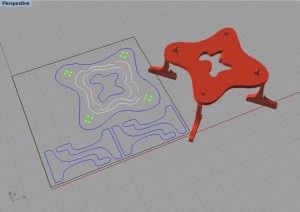Organic Small Table Model
I ended up making a small model for a table. I wanted to make an object that I liked so I went with the theme of making a design that feels organic. The table uses 2.5 axis milling profiling and engraving cuts.

I ended up making a small model for a table. I wanted to make an object that I liked so I went with the theme of making a design that feels organic. The table uses 2.5 axis milling profiling and engraving cuts.

For my final project I used black and white photographs of figures behind tracing paper, translated them into height maps in rhino, printed them with the CNC and then sanded and painted their surface. The process created a primitive kind of 3D imaging by treating the original photograph like a distance map and then translating that to 3D data. The resulting reliefs are a reflection on the computer’s desire to separate the figure from the surrounding noise.
For this project I wanted to try and push the boundaries of CNC jointery. Typically there is a specific aesthetic that is given to furniture or projects made with the router. Mainly the restriction comes from the 3 Axis limitation of milling into the stock, but also the restriction of the round router bit filleting every corner.
For this project I made 3 cuts that involved registering the stock on the table -> making a cut -> and then rotating -> and re-registering the stock for the next cut. I was able to do a large dovetail joint and also a custom lap joint.
Also part of my CNC testing early on was how to do 2-sided milling. My first attempt (referenced below) did not work because I made the mistake of not centering my virtual file in the center of my virtual stock. Therefore When I attempted to flip the actual material, the cut passed too deep through the material
I made use of the CNC Router in Doherty today. I cut molds for two carbon fiber panels to be used as driver close-outs in the Formula SAE race car. The foam was a 6lb/ft^3 density polyisocyanurate (polyiso for short). The foam has similar properties to polyurethane foam, such as closed cell (very tiny air bubbles), and importantly is not adversely affected by most solvents and can be coated with a wide variety of sealants, paints, and primers. These pieces were cut using a 1/2″ ball nose endmill for the horizontal roughing passes, then a 1/4″ ball nose endmill for the parallel finishing pass. Below are some in process and finished CNC shots. I’ll follow up with primered, sanded/polished, and carbon parts at a later date.
Description from website: WikiHouse is an open source construction set. It’s aim is to allow anyone to design, download, and ‘print’ CNC-milled houses and components, which can be assembled with minimal formal skill or training.
An article on it from Wired magazine: http://www.wired.co.uk/magazine/archive/2012/02/start/the-home-you-download

Excellent article on the Make Blog on cnc joinery, including discussions of laser-cutting vs. cnc routing (see section titled “Laser vs. Rotary Cutters – The Inside Corner Problem“), as well as wood-bending with cnc machinery (see “Flexures“).
This holder is designed possibly as a fruit basket or table ornament. The joints are waffle notch joints. I wanted to experiment between the CNC router and vacuum former in the dFAB lab. I was impressed with the variety of forms that developed out of each pocket of the waffled structure as the plastic formed and cooled.
I was never able to CNC route this because the times were really full and I didn’t want to take time away from people who were routing for their final project. What I wanted to make was a nest chair structure and I tried to design it so that it wouldn’t need glue to be held together.
Top view
Front view
Perspective shot 1
Perspective shot 2, rendered